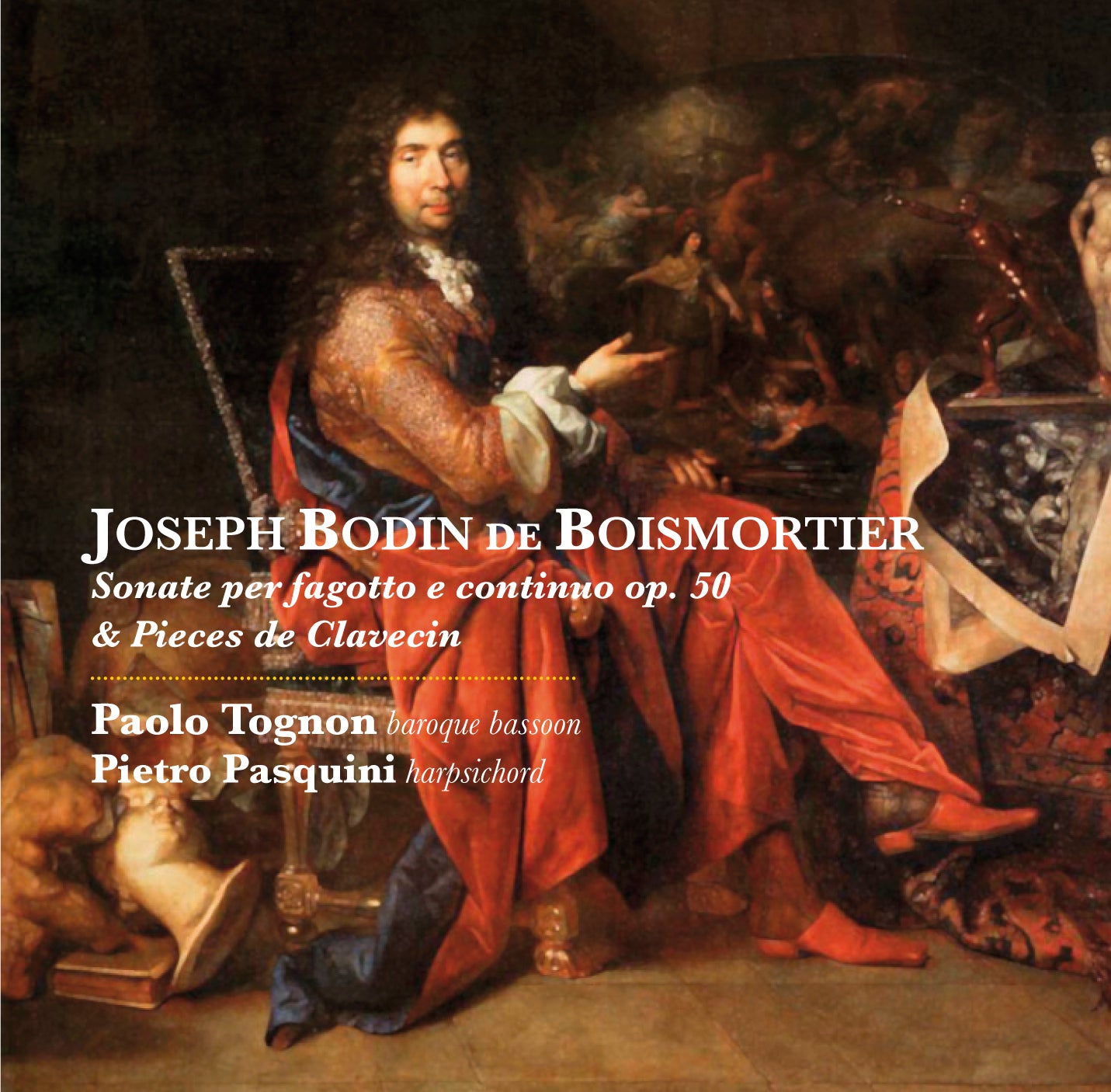Velut Luna
JOSEPH BODIN DE BOISMORTIER, SONATE PER FAGOTTO E CONTINUO OP. 50 & PIECES DE CLAVECIN - PAOLO TOGNON, PIETRO PASQUINI
JOSEPH BODIN DE BOISMORTIER, SONATE PER FAGOTTO E CONTINUO OP. 50 & PIECES DE CLAVECIN - PAOLO TOGNON, PIETRO PASQUINI
Genere musicale: Classica
Disponibile
Impossibile caricare la disponibilità di ritiro
JOSEPH BODIN DE BOISMORTIER, SONATE PER FAGOTTO E CONTINUO OP. 50 & PIECES DE CLAVECIN (CVLD208)
Autore: JOSEPH BODIN DE BOISMORTIER
Esecutore: PAOLO TOGNON PIETRO PASQUINI
Tracce
1 L’Imperièuse (troisièeme suite de pieces de clavecin) (1736) 3:03
Sonata Ia in Mi minore per fagotto e basso continuo op. 50 (1754)
2 Andante e Staccato 1:24
3 Allemanda (allegro) 2:26
4 Aria (affettuoso) 2:41
5 Gavotta (presto) 2:35
6 La Rustique (seconde suite de pieces de clavecin) 2:09
Sonata IIa in Sol maggiore per fagotto e basso continuo*
7 Largo 2:41
8 Allemanda (allegro) 2:44
9 Largo 1:24
10 Giga (staccato) 1:54
11 La Veloutèe (quatrième suite de pieces de clavecin) 1:54
Sonata IIIa in Re maggiore per fagotto e basso continuo
12 Moderato 2:22
13 Corrente 2:24
14 Aria (affettuoso) 2:29
15 Minoetto 1:10
16 Variatione Ia 1:07
17 Variatione IIa 1:00
18 Variatione IIIa 0:57
19 Variatione Iva 1:12
20 La Serènissime (seconde suite de pieces de clavecin) 2:07
Sonata IVa in Re minore per fagotto e basso continuo*
21 Andante 2:15
22 Allegro 2:29
23 Sarabanda 1:31
24 Giga 2:22
25 La Marguillièere (prèmiere suite de pieces de clavecin) 2:51
Sonata Va in Do minore per fagotto e basso continuo*
26 Largo 2:16
27 Gavotta 1:35
28 Largo 0:47
29 Allegro 1:41
Total Time 57:45
Classical. Original compositions by Joseph Bodin De Boismortier. Paolo Tognon baroque bassoon, Pietro Pasquini harpsichord. 24bit/88.2kHz original recorded, mixed and mastered at Areamagister Studios, Preganziol, Italy, on December 7, 8, 9, 2010
Il fagotto in Francia, nel XVIII secolo, era ampiamente utilizzato per la sua efficacia espressiva. Si deve probabilmente a Jean Hotteterre il suo iniziale sviluppo costruttivo. Già nel 1674, il fagotto, è nominato in una partitura di Lully e le prime testimonianze di un fagotto a quattro chiavi (jn seguito anche cinque) sono di due strumenti originali datati fra il 1730 e il 1750ca documentate da costruttori come Eisel, 1738 per arrivare fino alla celebre illustrazione nell’Encyclopédie di Diderot e D’Alembert del 1751. J.B. de Boismortier, introdusse in Francia il concerto tripartito di origine italiana che ebbe come antesignani Vivaldi ed Albinoni. Contribuì inoltre al miglioramento della tecnica flautistica. Iniziò lo studio della musica sotto la guida di Joseph Valette de Montigny, nel 1714. Operò inizialmente a Metz per trasferirsi a Parigi nel 1724, dove appena giunto pubblicò 12 triosonate per 2 flauti con basso continuo, 12 sonate per 2 flauti e 4 cantate. Avviò una produzione strumentale di elevata qualità privilegiando i gusti eleganti degli aristocratici. Compose inoltre 3 opere, cantate varie. Fu sua la musica che venne suonata il Natale e la vigilia presso il Concert Spirituel dal 1740 al 1770. Fine conoscitore anche degli strumenti gravi dell’orchestra, quali violoncello, fagotto, viola da gamba, venne in contatto con il mondo del violoncello verso la fine degli anni ‘20, allorché si recò per studiare presso di lui Jean Zewalt Triemer, originario di Weimar dove fu membro dell’orchestra di corte; emigrò a Parigi e tra il 1726 e il 1729, fu anche allievo di Boismortier. La raccolta delle cinque sonate op. 50 possono espressamente essere suonate dal violoncello, fagotto o viola da gamba, secondo la consolidata abitudine a stampa dell’epoca che poteva così garantire maggior circolazione ed interesse delle composizioni fra i musicisti dell’epoca. La raccolta, utilizzata per questa registrazione proviene dall’edizione a stampa storica del 1735 conservata rispettivamente presso la Bibliothèque National de France e la British Library di Londra. La struttura compositiva delle sonate mescola abilmente l’alternanza di movimenti lenti e veloci secondo lo stile italiano, e sono presenti tipiche danze francesi presenti in tutte le sonate, quali: allemanda, gavotta, giga, sarabanda, corrente, minuetto. Interessante la presenza dell’affettuoso nella prima e terza sonata in cui la mescolanza del cantabile e della timbrica peculiare del fagotto nel registro tenorile, lievemente malinconico, ne esalta la componente espressiva. Boismortier è perfettamente dentro lo spirito dei “Goutès Rèunis” ovvero quel movimento musicale francese del ‘700 che ambiva a un ideale connubio musicale fra melodia cantabile e virtuosismo tipico degli italiani, con la raffinata ornamentazione francese tipica delle comédie-ballet . Il fagotto viene esplorato in tutte queste risorse e si adatta perfettamente all’ esecuzione. Ad integrare la registrazione, alcuni brevi pièce de clavecin, provenienti dalla raccolta di quattro suites per cembalo del 1736. Si tratta di brani a forma chiusa piuttosto brevi, che già nella titolazione apposta dall’autore, vogliono evocare una atmosfera precisa: l’Impèrieuse, la Veloutèe, la Rustique oppure una sorta di omaggio sottinteso a qualche personalità: La Sèrenissime, la Marguillière. Spesso, in questi brani, è presente la forma compositiva del rondeau, che alternato con il couplet rende più vario l’ascolto della musica stessa.
Share

-

Spedizioni prodotti fisici
Spedizioni gratuite in Europa (UE), a partire da 4 articoli - Richiedere quatozione per i costi di spedizione per i paesi non UE
-

Consegna prodotti digitali
La consegna dei prodotti digitali avverrà direttamente sul sito e riceverai anche una email con il link per il download dei file.
-

Scrivi una recensione
Qui sopra puoi scrivere una recensione sul prodotto che hai acquistato, saremo felici di conoscere la tua opinione.


